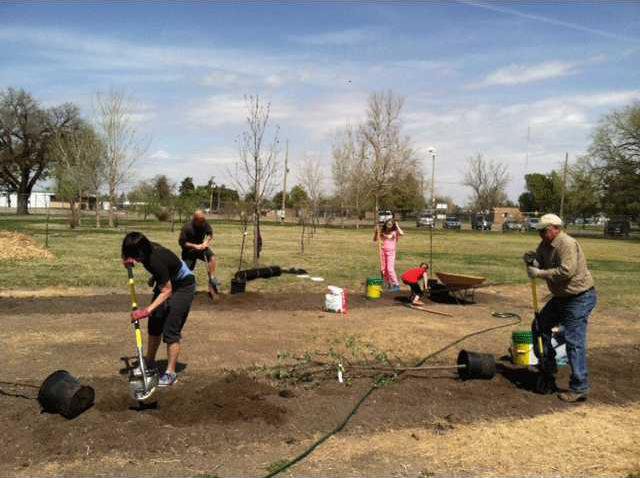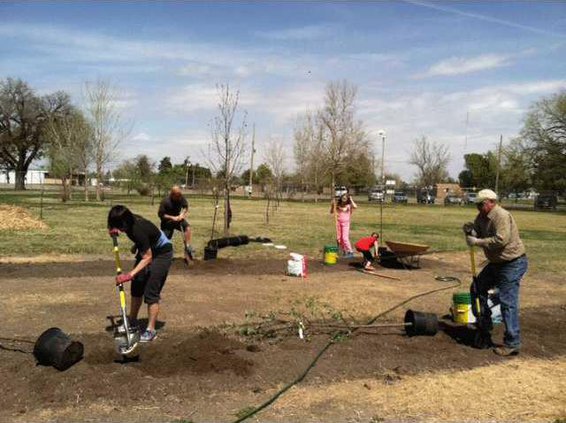Saturday afternoon, community volunteers from several organizations met at the Brit Spaugh zoo to plant the seeds of a project that years from now will bear fruit for the city – literally.
The first 12 trees of a community orchard were installed at the north end of the zoo where a greenhouse was once located. This space between the butterfly house and the black bear exhibit is now home to three varieties of apples selected by Barton County Extension Ag Agent Alicia Boor and donated by the Great Bend Tree Board which has added its support to the project.
“Trees are vastly important, and to be able to have a place where they can used for harvesting fresh food to backgrounds for photography provides more opportunity for community involvement,” Boor said.
She obtained a grant for the zoo orchard through the Golden Belt Community Foundation, with the City of Great Bend’s blessing. This is good for many reasons. Its behind a fence, so its protected yet open to anyone visiting the zoo. Its also close to a water source.
“The City Administrator (Howard Partington) is very supportive of the idea and knows it is a long-term commitment to have an orchard in the zoo,” Boor said.
Meet me in the orchard
The vision is fluid at this point. What is needed is a group of dedicated people willing to make the time to help. That can be developed over time, she realizes. In the future, the orchard could be a focal point for fall harvest days, master gardener demonstrations, and service projects for Scouting and 4-H groups. Those who help tend the orchard could take part in the fruit, and it could supply both apple wood and apples for some of the zoo animals.
“The trees, of course, aren’t going anywhere,” she said. “Whatever the community wants to do with them can be part of the vision.”
Off to a good start
Now that the trees have been planted, they will not need fertilizer for the first few years, and weed barrier and mulch have been put down, so weeding will not be necessary. Watering is the main concern until they are established. That is something that can be monitored during her daily walks at the park, she said.
If rain is not forthcoming, she’s prepared to put the advice she gives Extension clients to work. While the trees are young, five gallons of water a week is sufficient to establish them, and that can be done by filling up 5-gallon containers (drill one or two holes in the bottom) and allowing them to slowly seep out over the course of a few hours. Its a manageable task in a small orchard of 12 trees.
Starting small
Boor opted to start small in order to garner community support before expanding. If help is forthcoming, there are grants available to make that possible, she said. Right now, the Tree Board is working on getting signage that matches those recently installed in the Argonne Forest at Veterans Memorial Park. Other businesses in the county have suggested ways they can help in the future. An official ribbon-cutting will be announced closer to the fall when the trees have become established.
Balancing care with taste
The location requires strict care be taken to only use minimal and approved treatments for pests, something Boor is very aware of having several years experience working with zoos in Great Bend and Wichita. Disease resistance was at the top of the list of important qualities the trees selected for the orchard had to have. But the apples also had to be good for eating and making cider with. Finally, the stock had to be available. In the end, the varieties chosen were Haralson (excellent, distinctive, tart flavor, very crisp and juicy, keeps well) , Red Delicious, and Ashmead’s Kernal(“explodes with champagne-sherbet juice infused with a lingering scent of orange blossom...dense, sugaray and aromatic with intense flavor) .
The Great Bend Tree Board donated the trees, all of which were at least a few years old and ready to blossom. Boor was also pleased to learn the board has pledged to replace any that may be lost during this transition period after transplanting.
“If they establish quickly, we could have a small harvest in a few years,” she said.
A time-tested movement
The modern community orchard movement started in 1992 in the United Kingdom when the charity Common Ground suggested the idea of creating or conserving orchards by and for the local people. The vision was to bring back community spaces that were an asset for the whole parish. Up until the beginning of the industrial revolution, just about every farmstead and village in England had a community orchard, according to the organization’s website.
“Community Orchards help to revive an interest in fruit growing, provide a way of sharing knowledge and horticultural skills and stimulate us into growing food for ourselves again.” the founders wrote.
In the U.S., several examples of community orchards can be found, in public parks (The City of Seattle’s P-Patch program) schools, colleges, churches, reservations, and more. According to the National Sustainable Agriculture Information Service, a community orchard is simply an orchard that is not being managed for private profit and is cared for by some community of people.
Project taking root
First trees in community orchard now in the ground





